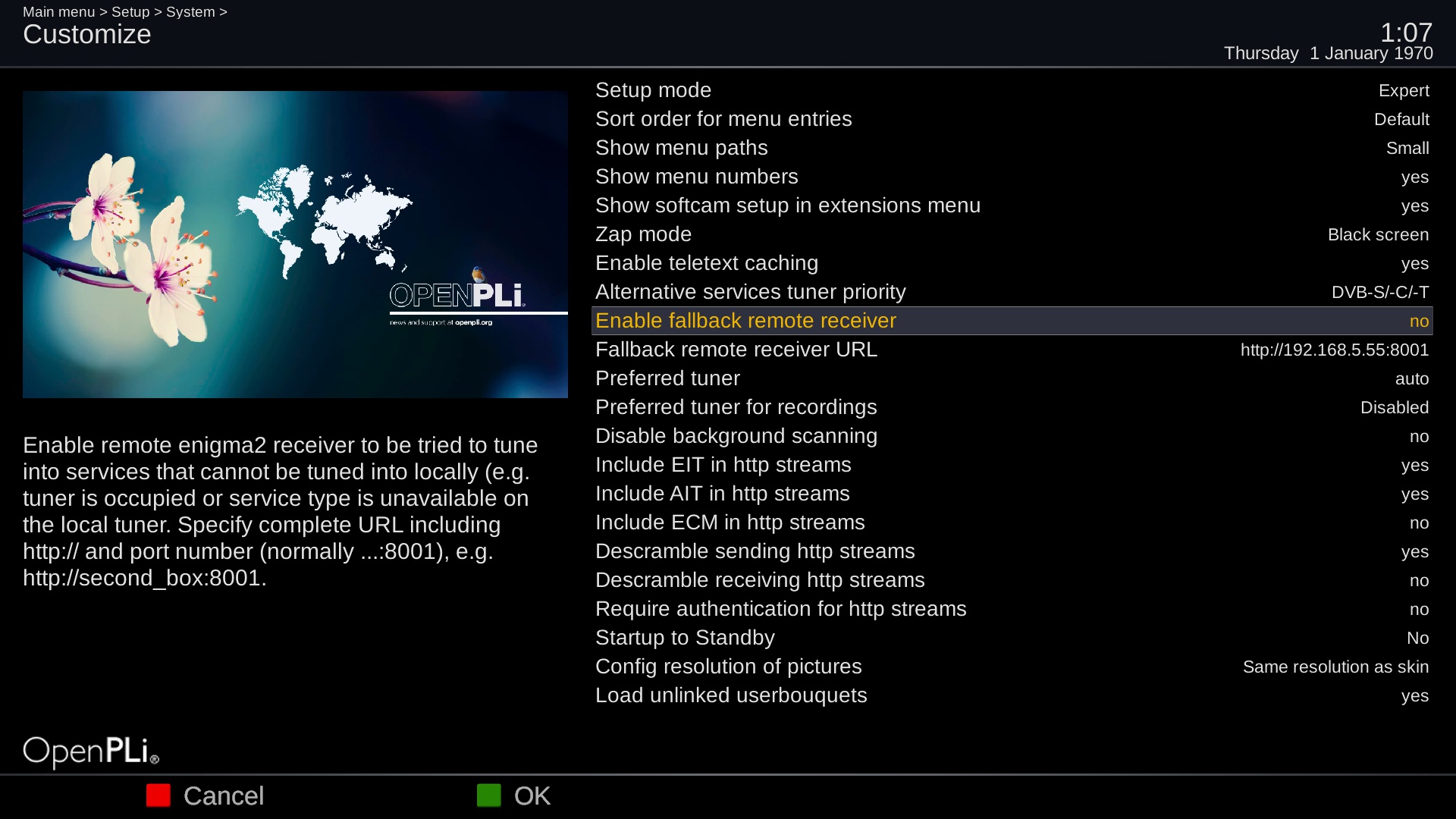Fallback remote receiver
Intro
"remote streaming
To start at the beginning, for those who are new to enigma2. Enigma2 can send a channel via http over the network to another device (this is often called streaming). That other device can be a computer / laptop / smartphone / tablet. Normally it will go through the web interface, or an app, but it can also be compiled directly by the right url.
The other way up is less known, can also. A device that can provide a http stream according to DVB standards (otherwise, too, but does not work so well for a long time, so I can not talk about that for a moment), can play enigma2.
Remote Fallback tuner and Remote Stream converter
If you combine these two possibilities, you'll get "remote" streaming on your enigma2 receiver. Many users are already familiar with the "remote stream converter" plugin, requesting and converting another recipient's bouquets to view them on your recipient.
Why would you like this? Well, you'll need more than 1 recipient!
- Make more recordings at once by using multi-receiver tuners combined
- Make satellite posts available to recipients who do not have LNB / cable for themselves
- Use a receiver at a location where no satellite / cable TV cables can be connected
This could all already be done with the remote stream converter plugin. The remote fallback tuner is an alternative to that, for the one will be more convenient for the other.
Where you use the remote stream converter to list once-only services (TV channels) from another receiver, the remote fallback tuner will work dynamically. Each time a "Tuner" is tuned to a channel (Live Watch, Recording, PiP), the remote fallback tuner will check if this station is available. There are a number of reasons why a channel can not be "tuned":
- All tuners in use
- The transmitter is in a satellite position that is not available on the tuner (s) that are still available
- Transmitter is different DVB type than available tuners (DVB-T / C / S, say digitenne, Ziggo / UPC or CDS / TVV)
- Receiver does not have any tuners connected.
Normally, a message is shown that the corresponding station can not be displayed. In the channel overview these channels are dark gray.
How to active the Remote Fallback Tuner
- Go to Menu > Setup > System > Customize
- Go to the line Enable fallback remote receiverand set it to yes
- On the next line Fallback remote receiver URL you add the IP address of the box (you can, but you don't have to add the port number as it will automatically be added) of a recipient that also has active tuners that can be used.
So now if a channel can not be displayed, this box will be contacted and the channel will be retrieved from there and displayed (provided that is available, of course!). Channels that are not available on their own receiver, but via remote fallback tuner (and if enabled) are shown in light gray in the channel list.
In short, it means that you virtually receive the tuners of another recipient. Of course, your own tuners always have priority, it's really a "fallback".
Every benefit has a disadvantage. To make this work well, it is necessary that both recipients have the same lamedb. The what??? The lamedb is a file in which all kinds of data about transponders, frequencies and stations are stored. It is usually updated by performing a scan, by installing a station list or by doing fast scan / cable scan. As a user, you normally do not have anything to do with it. But it must be equal to both recipients. There are a number of possibilities.
- The two receivers have the same types of connections and also use both the same "external" channel list (for example, Henksat): no problem, it goes without saying
- idem, but scanned by yourself: then take over the lamedb (see below)
- The <server_ontvanger> has more positions / DVB types: retrieve lamedb from this receiver
- Both recipients have different positions / DVB types: then it must be merged, see below.
Copy of lamedb: stop enigma2 (init 4) so all adjustments are written, then with scp or ftp retrieve the file / etc / enigma2 / lamed. Then on the recipient recipient also quit enigma2 with init 4 and put the file in / etc / enigma2 / lamedb. After that, enigma2 can be restarted on both receivers with init 3.
Combining lamedb: Similar, but: Perform a full scan on the first receiver, then copy the LAMEDB to the second receiver, perform a full scan again and then re-copy the LAMEDB file to the first recipient!
Maybe this is all to difficult to comprehend, but for most users, nothing will have to be copied.
Editttttttinnggg page 1/3--
